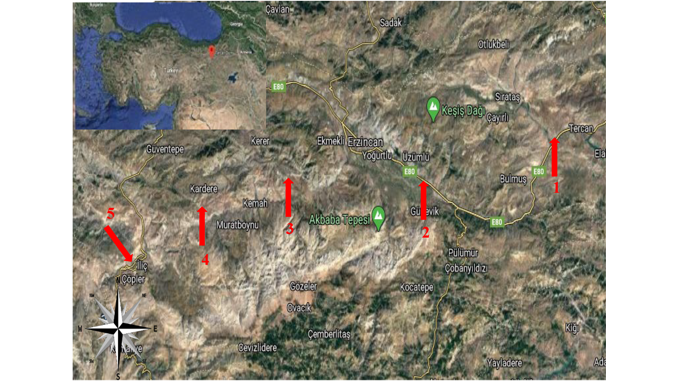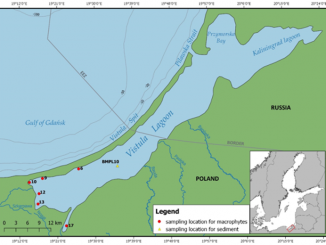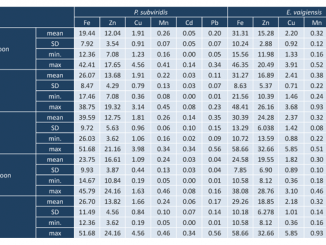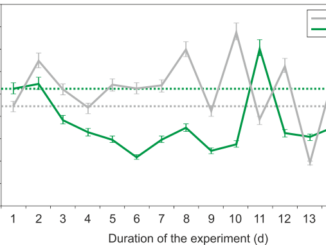
Paper category: Original research paper
Corresponding author: Özge Zencir Tanır (zencir06@hotmail.com)
DOI: 10.1515/ohs-2021-0020
Received: 20/10/2020
Accepted: 01/12/2020
Full text: here
Citation (APA style): Tanır,Ö.(2021).Determination of heavy metals in some tissues of four fish species from the Karasu River (Erzincan, Turkey) for public consumption. Oceanological and Hydrobiological Studies,50(2) 232-246. https://doi.org/10.2478/oandhs-2021-0020
Abstract
The study aimed at determining the concentration of heavy metals in muscle, liver, and gill tissues of four fish species (Acanthobrama marmid, Capoeta umbla, Capoeta trutta and Chondrostoma regium) collected from five sites in the Karasu River, Erzincan, between July 2019 and January 2020. The relationships between fish size (length and weight) and metal concentrations in the tissues were also investigated using Pearson correlation analysis. Concentrations of Al, Fe, Cu, Mn and Zn were higher than those of other metals in all tissue samples from four fish species. Fe and Al concentrations were very high, while the lowest Co, Cd and Pb concentrations were determined in the muscle, liver and gill tissues. The results of Pearson correlation analysis showed that significant relationships between heavy metal concentrations and fish size (length and weight) were positive (p < 0.01, p < 0.05), except for a few cases. Furthermore, heavy metal concentrations in the edible parts (muscle) of the studied fish species did not exceed the maximum acceptable concentrations (MACs) proposed by national and international food standards and were safe within human consumption limits, except for Cr.
Conclusions
Fish are at the top of the aquatic food chain. They are indicators of the water quality status and of water pollution, especially by heavy metals. In freshwater, heavy metals accumulate more in fish species (Cyprinidae) that feed on sediment (Cağlar et al. 2019). In this context, the present study was carried out to provide information on heavy metal concentrations in muscle, liver, and gill tissues of Tigris scraper, trout barb, Tigris bream, and Mesopotamian nase inhabiting the Karasu River, which are consumed by local people, and to evaluate the relationships between the size (length and weight) of the fish and the concentrations of metals in their tissues. The highest concentrations of heavy metals were found in gills or liver, while the lowest concentrations were found in muscle. Muscle was not an active tissue in the accumulation of heavy metals. The accumulation of metals varied depending on species-specific factors, including mainly feeding behavior, fish size and age. The results of Pearson correlation analysis showed that, except for a few cases, significant correlations between metal concentrations and fish size (length and weight) were positive (p < 0.01, p < 0.05). Furthermore, heavy metal concentrations recorded in the edible parts of the four fish species studied were within the permissible limits set by national or international organizations for human consumption. It was concluded that the determined concentrations of heavy metals in fish collected from the Karasu River did not pose any threat to human health. Although the levels of the analyzed metals were below the recommended limits for human consumption, a potential risk could arise for people consuming fish depending on the size of fish and the load of heavy metals in the area. People living around the river and the authorities of these areas, in particular, should be made aware of these issues, as well as informed about fertilizers and treatment of domestic wastewater.
Future studies are recommended to more comprehensively determine the relationship between the content of heavy metals in sediments and their levels in fish, taking into account the physicochemical properties of water, including heavy metal content.
Acknowledgements
This study was supported by the Erzincan Binali Yıldırım University Scientific Research Projects Coordination Unit (Project No. FBA-2019-634). I would like to thank Erzincan Binali Yıldırım University, Scientific Research Projects Unit for their financial support and Dr. Hülya TÜRK for her help in the analysis of metals by ICP-MS, Assoc. Prof. Özden FAKIOĞLU, Assoc. Prof. Harun ARSLAN and Assoc. Prof. Selçuk ÖZDEMİR for their help in field studies.
References
Agah, H., Leermakers, M., Elskens, M., Fatemi, S.M.R. & Baeyens, W. (2009). Accumulation of trace metals in the muscle and liver tissues of five fish species from the Persian Gulf. Environ. Monit. Assess. 157: 499–514. DOI: 10.1007/s10661-008-0551-8.
Aktan, N. & Tekin-Özan, S. (2012). Levels of some heavy metals in water and tissues of chub mackerel (Scomber japonicus) compared with physico-chemical parameters seasons and size of the fish. J. Anim. Plant Sci. 22(3): 605–613.
Altndağ, A. & Yiğit, S. (2005). Assessment of heavy metal concentrations in the food web of Lake Beyşehir, Turkey. Chemosphere 60(4): 552–556. DOI: 10.1016/j.chemosphere.2005.01.009.
Al-Yousuf, M.H., El-Shahawi, M.S. & Al-Ghais, S.M. (2000). Trace metals in liver, skin and muscle of lethrinus lentjan fish species in relation to body length and sex. Sci. Total Environ. 256: 87–94. DOI: 10.1016/s0048-9697(99)00363-0.
American Public Health Association. (1985). Standard method for the examination of water and wastewater. In: 16th Edition, American Public Health Association, Washington DC.
Aydoğan, Z., Şişman, T., İncekara ,Ü. & Gürol, A. (2017). Heavy metal accumulation in some aquatic insects (Coleoptera: Hydrophilidae) and tissues of Chondrostoma regium (Heckel, 1843) relevant to their concentration in water and sediments from Karasu River, Erzurum, Turkey. Environ. Sci. Pollut. Res. 4(10): 9566–9574. DOI: 10.1007/s11356-017-8629-x.
Agency for Toxic Substances and Disease Registry. (2013). Priority list of hazardous substances. Agency for Toxic Substances and Disease Registry. Atlanta, Georgia.
Başyiğit, B. & Tekin-Özan, S. (2013). Concentrations of some heavy metals in water, sediment and tissues of Pikeperch (Sander lucioperca) from Karataş Lake related to physico-chemical parameters, fish size and seasons. Pol. J. Fish. Aqua. Sci. 22: 11–22.
Cağlar, M., Canpolat, O. & Selamoglu, Z. (2019). Determination of some heavy metal levels in three freshwater fish in Keban Dam Lake (Turkey) for public consumption. Iran. J. Fish. Sci. 18(1): 188–198. DOI: 10.22092/ijfs.2018.117890.
Canpolat, O. & Calta, M. (2003). Heavy metals in some tissues and organs of Capoeta capoeta umbla (Heckel, 1843) fish species in relation to body size, age, sex and seasons. Fres. Environ. Bullet. 12: 961–966.
Canlı, M., Ay, Ö. & Kalay, M. (1998). Levels of heavy metals (Cd, Pb, Cu, Cr and Ni) in tissue of Cyprinus carpio, Barbus capito and Chondrostoma regium from the Seyhan River, Turkey. Turk. J. Zool. 22: 149–157.
Canlı, M. & Atlı, G. (2003). The relationships between heavy metal (Cd, Cr, Cu, Fe, Pb, Zn) levels and the size of six Mediterranean fish species. Environ. Pollut. 121: 129–36. DOI: 10.1016/S0269-7491(02)00194-X.
Çalta, M. & Canpolat, Ö. (2006): The comparison of three Cyprinid species in terms of heavy metal accumulation in some tissues. Water Environ. Res. 78: 548−551. DOI: 10.2175/106143006X99849.
Canpolat, O. (2013). Accumulation factor of heavy metals in Capoeta umbla fish. Environ. Bullet.78: 548−551.
Canpolat, O., Eroğlu, M., Çoban, M.Z. & Düşükcan, M. (2014). Transfer factors and bioaccumulation of some heavy metals in muscle of a freshwater fish species: A human health concern. Fres. Environ. Bullet. 23: 418−425.
Censi, P., Spoto, S. E., Saiano, F., Sprovieri, M., Mazzola, S. et al. (2006). Heavy metals in coastal water systems. A case study from the northwestern Gulf of Thailand. Chemosphere 64: 1167–1176. DOI: 10.1016/j.chemosphere.2005.11.008.
Demirak, A., Yılmaz, F., Tuna, A.L. & Özdemir, N. (2006). In water, sediment and tissues of Leuciscus cephalus from a stream in southwestern Turkey. Chemosphere 63: 1451– 1458. DOI: 10.1016/j.chemosphere.2005.09.033.
Dalzochio, T., Ressel Simoes, L.A, Santos de Souza, M., Prado Rodrigues, G.Z., Petry et al. (2017). Water quality parameters, biomarkers and metal bioaccumulation in native fish captured in the Ilha River, Southern Brazil. Chemosphere 189: 609–618. DOI: 10.1016/j.chemosphere.2017.09.089.
Dane, H. & Şişman, H. (2020). Effects of heavy metal pollution on hepatosomatic index and vital organ histology in Alburnus mossulensis from Karasu River. Turk. J. Vet. Anim. Sci. 44: 607–617.
Danabas, D., Kutluyer, F., Ural, M. & Kocabas, M. (2020). Metal bioaccumulation in selected tissues of barb (Barbus sp.) and common carp (Cyprinus carpio, Linnaeus 1758) from the Keban Dam Lake, Turkey. Tox. Rev. 39(1): 78–85. DOI: 10.1080/15569543.2018.1479717.
Düşükcan, M., Canpolat, Ö. & Eroğlu, M. (2017). Some heavy metal in Luciobarbus esocinus for public consumption and consumer protection. Cell. Mol. Biol. 63: 24–28. DOI: 10.14715/cmb/2017.63.9.5.
Düsükcan, M. (2018). Some heavy metals in the flesh of chub, Squalius cephalus, from Karakaya Dam Lake (Malatya, Turkey). Cell. Mol. Biol. 64(3): 92–96. DOI: 10.14715/cmb/2018.64.3.15.
European Commission. (2006). Commission Regulation Maximum levels for certain contaminants in foodstuffs. EC. No: 1881/2006.
Elbeshti, R.T., Elderwısh, N.M., Abdelalı, K.M.K. & Taştan, Y. (2018). Effects of Heavy Metals on Fish. Menba. J. Fish. Fac. 4(1): 36–47.
El-Moselhy, K.M., Othman, A.I., Abd El-Azem, H. & El-Metwally, M.E.A. (2014). Bioaccumulation of heavy metals in some tissues of fish in the Red Sea, Egypt. Egypt. J. Bas. Appl. Sci. 1(2): 97–105. DOI: 10.1016/j.ejbas.2014.06.001.
Eroğlu, M., Düşükcan, M. & Canpolat, Ö. (2016). Some heavy metals in the muscle of Capoeta trutta : risk assessment for the consumers. Cell. Mol. Biol. 62: 22–26. DOI: 10.14715/cmb/2016.62.6.4.
Erdogrul, Ö. & Erbilir, F. (2007). Heavy metal and trace elements in various fish samples from Sır Dam Lake, Kahramanmaraş, Turkey. Environ. Monit. Assess. 130(1–3): 373–379. DOI: 10.1007/s10661-006-9404-5.
Food and Agriculture Organization. (1983). Compilation of legal limits for hazardous substances in fish and fishery products, FAO Fishery Circulars No:764, Fish and Agriculture Organization, Roma, Italy.
Food and Agriculture Organization/World Health Organization. (1989). Evaluation of certain food additives and the contaminants mercury, lead and cadmium, WHO Technical Report, Series No. 505.
Farkas, A., Salánki, J. & Specziár, J. (2003). Age-and size-specific patterns of heavy metals in the organs of freshwater fish Abramis brama L. populating a low-contaminated site. Wat. Res. 37: 959–964. DOI: 10.1016/S0043-1354(02)00447-5.
Fırat, Ö., Fırat, Ö., Çoğun, H.Y., Aytekin, T., Firidin, G. et al. (2018). Comparison of heavy metal levels in tissues of fish caught from the dirty and clean areas of Atatürk Dam Lake (Silurus triostegus Heckel, 1843, Chalcalburnus tarichi Pallas, 1811, Chondrostoma regium Heckel, 1843, Carassius carassius Linnaeus, 1758). J. Eğirdir Fish. Fac. 14: 173−183. (In Turkish).
Görür, F.K., Keser, R., Akcay, N. & Dizman, S. (2012). Radioactivity and heavy metal concentrations of some commercial fish species consumed in the Black Sea Region of Turkey. Chemosphere 87: 356–361. DOI: 10.1016/j.chemosphere.2011.12.022.
Gunes, M., Sökmen, T.Ö. & Kırıcı, M. (2019). Determination of some metal levels in water, sediment and fish species of Tercan Dam Lake, Turkey. Appl. Ecol. Environ. Res. 17(6): 14961–14972. DOI: 10.15666/aeer/1706_1496114972.
Indrajith, H.A.P., Pathirane, K.A.S. & Pathirane, A. (2008). Heavy metal levels in two food fish species from Negombo estuary, Sri Lanka; Relationships with the body size. Sri Lanka J. Aquat. Sci.13: 63–81. DOI: 10.4038/sljas.v13i0.2207.
Kaçar, E. & Karadede-Akın, H. (2019). Seasonal variations of heavy metals in some tissues of Chondrostoma regium (Heckel, 1843) from Batman Dam, Turkey. J. Inst. Sci. Tech. 9(4): 1944–1952. DOI: 10.21597/jist.579326.
Kalkan, H., Şişman, T. & Kılıç, D. (2015). Assessment of heavy metal bioaccumulation in some tissues of Leuciscus cephalus from Karasu River, Erzurum-Turkey. Aust. J. Environ. Toxicol. 1(1): 1–6.
Karadede, H. & Ünlü, E. (2000). Concentrations of some heavy metals in water, sediment and fish species from the Atatürk Dam Lake (Euphrates), Turkey. Chemosphere 41: 1371–1376. DOI: 10.1016/S0045-6535(99)00563-9.
Karadede, H., Oymak, S.A. & Ünlü, E. (2004). Heavy metals in mullet, Liza abu, and catfish, Silurus triostegus, from the Atatürk Dam Lake (Euphrates), Turkey. Environ. Inter. 30: 183–188. DOI: 10.1016/S0160-4120(03)00169-7.
Kasımoğlu, C. (2014). The effect of fish size, age and condition factor on the contents of seven essential elements in Anguilla anguilla from Tersakan Stream Muğla (Turkey). J. Pollut. Eff. Cont. 2(2): 1–6. DOI: 10.4172/2375-4397.1000123.
Langston, W.J. (1990). Toxic effects of metals and the incidence of marine ecosystems. In R.W. Furness & P.S. Rainbow (Eds.), Heavy Metals in the Marine Environment. CRC Press, New York.
Liu, J-L., Xu, X-R., Ding, Z-H., Peng, J-X., Jin, M-H. et al. (2015). Heavy metals in wild marine fish from South China Sea: Levels, tissue-and specific-specific accumulation and potential risk to humans. Ecotoxicology 24: 1583–1592. DOI: 10.1007/s10646-015-1451-7.
Mendil, D., Unal, O.F., Tuzen, M. & Soylak, M. (2010). Determination of trace metals in different fish species and sediments from the River Yeşilırmak in Tokat, Turkey. Food Chem. Tox. 48: 1383–1392. DOI: 10.1016/j.fct.2010.03.006.
Öztürk, M., Özözen, G., Minareci, O. & Minareci, E. (2009). Determination of heavy metals in fish, water and sediments of Avsar Dam Lake in Turkey. Iran. J. Environ. Heal. Sci. Engin. 6: 73–80.
Olgunoğlu, M.P., Olgunoğlu, I.A. & Bayhan, Y.K. (2015). Heavy metal concentrations (Cd, Pb, Cu, Zn, Fe) in giant red shrimps (Aristaeomorpha foliacea Risso 1827) from the Mediterranean Sea. Pol. J. Environ. Stud. 24: 631–635. DOI: 10.15244/pjoes/33201.
Ploetz, D.M., Fitts, B.E. & Rice, T.M. (2007). Differential accumulation of heavy metals in muscle and liver of a marine fish, (king mackerel, Scomberomorus cavalla Cuvier) from the Northern Gulf of Mexico, USA. Bullet. Environ. Contam. Tox. 78: 134–137. DOI: 10.1007/s00128-007-9028-7.
Roesijadi, G. & Robinson, W.E. (1994). Metal regulation in aquatic animals: mechanism of uptake, accumulation and release. In D.C. Malins & G.K. Ostrander (Eds.), Aquatic Toxicology: Molecular, Biochemical and Cellular Perspectives (pp. 387–420). Lewis Publishers: London.
Saler, S., Bulut, H., Birici, N., Tepe, R. & Alpaslan, K. (2015). Zooplankton of Karasu River (Erzincan). J. Eğirdir Fish. Facul. 11(1): 10–16. (In Turkish).
Sokmen, T.O., Guneş, M. & Kırıcı, M. (2018). Determination of heavy metal levels in water, sediment and Capoeta umbla tissues of Karasu River (Erzincan). Turk. J. Agricul. Natur. Sci. 5: 578–588 (In Turkish). DOI: 10.30910/turkjans.471355.
Sonmez, A.Y., Yaganoglu, A.M., Arslan, G. & Hisar, O. (2012). Metals in two species of fish in Karasu River. Bullet. Environ. Contam. Tox. 89: 1190–1195. DOI: 10.1007/s00128-012-0841-2.
Turkish Food Codex. (2002). Official Gazette of Republic of Turkey. Notifications about determination of the maximum levels for certain contaminants in foodstuffs of Turkish Food Codex (Notification No: 2002/63), Issue: 24885. (In Turkish).
Ural, M., Yildirim, N., Danabas, D., Kaplan, O., Cikcikoglu et al. (2012). Some heavy metals accumulation in tissues in Capoeta umbla (Heckel, 1843) from Uzuncayir Dam Lake (Tunceli, Turkey). Bullet. Environ. Contam. Tox. 88: 172–176. DOI: 10.1007/s00128-011-0474-x.
Ural, M. & Danabas, D. (2015). Some metal levels in gill, liver, kidney and muscle tissues of Capoeta trutta (Heckel, 1843) in Keban Dam Lake (Euphrates-Turkey). Inter. J. Pure Appl. Sci. 1: 16–24.
Yi, Y.J. & Zhang, S.H. (2012). The relationships between fish heavy metal concentrations and fish size in the upper and middle reach of Yangtze River. Procedia Environ. Sci. 13: 1699–1707. DOI: 10.1016/j.proenv.2012.01.163.
Zyadah, M.A. (1999). Accumulation of some heavy metals in Tilapia zilli organs from Lake Manzalah, Egypt. Turk. J. Zool. 23: 365–372.
Widianarko, B., Van Gestel, C.A.M., Verweij, R.A. & Van Straalen, N.M. (2000). Associations between trace metals in sediment, water, and guppy, Poecilia reticulata (Peters), from urban streams of Semarang, Indonesia. Ecotox. Environ. Safe 46: 101–107. DOI: 10.1006/eesa.1999.1879.
World Health Organization (WHO). (1993). Guidelines for Drinking-Water Quality, Recommendations. 2nd Ed., Geneva.



